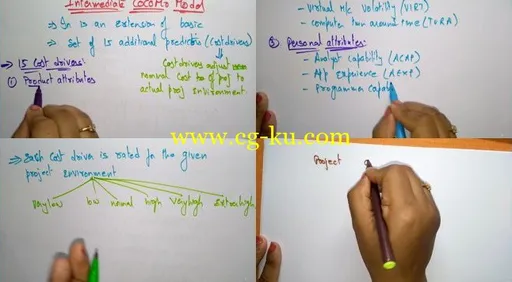 Duration: 1.5 hours | Video: h264, 1280x720 | Audio: AAC, 44 KHz, 2 Ch | 1.7 GB
Duration: 1.5 hours | Video: h264, 1280x720 | Audio: AAC, 44 KHz, 2 Ch | 1.7 GB
$200 | Created by Aishwarya Mukherjee | Last updated 7/2018
Genre: eLearning | Language: English + Sub | 9 Lectures
Learn the software engineering topics on COCOMO Model, Risk Management and Requirements Engineering
What Will I Learn?
Learn about COCOMO Model
Understand about scenario based modeling and data dictionary
Know about risk management
Learn about requirements engineering
Requirements
An interest in software engineering
Description
Cocomo (Constructive Cost Model) is a regression model based on LOC, i.e number of Lines of Code. It is a procedural cost estimate model for software projects and often used as a process of reliably predicting the various parameters associated with making a project such as size, effort, cost, time and quality. It was proposed by Barry Boehm in 1970 and is based on the study of 63 projects, which make it one of the best-documented models.
The key parameters which define the quality of any software products, which are also an outcome of the Cocomo are primarily Effort & Schedule:
Effort: Amount of labor that will be required to complete a task. It is measured in person-months units.
Schedule: Simply means the amount of time required for the completion of the job, which is, of course, proportional to the effort put. It is measured in the units of time such as weeks, months.
Different models of Cocomo have been taught in this course to predict the cost estimation at different levels, based on the amount of accuracy and correctness required. All of these models can be applied to a variety of projects, whose characteristics determine the value of constant to be used in subsequent calculations.
Risk management means risk containment and mitigation. First, you’ve got to identify and plan. Then be ready to act when a risk arises, drawing upon the experience and knowledge of the entire team to minimize the impact to the project.
Risk management includes the following tasks:
Identify risks and their triggers
Classify and prioritize all risks
Craft a plan that links each risk to a mitigation
Monitor for risk triggers during the project
Implement the mitigating action if any risk materializes
Communicate risk status throughout project
The software requirements are description of features and functionalities of the target system. Requirements convey the expectations of users from the software product. The requirements can be obvious or hidden, known or unknown, expected or unexpected from client’s point of view.
Who is the target audience?
Software Students
Software Engineers
Software Testers
Software Professionals

Password/解压密码-0daydown




发布日期: 2018-08-05